
From Book One to Finale: Ensuring Cohesion in Your Series

Writing a book series is a rewarding yet complex endeavor. Unlike standalone novels, series require meticulous planning and a long-term vision to ensure cohesiveness and consistency. Here’s a guide to help you prepare your book series, focusing on critical elements such as outlining, character development, plot continuity, and maintaining a detailed timeline.
1. Outlining Your Series
Develop a Master Plan
Start by creating a master outline for your entire series. This overview should include the main plot arcs, key events, and how each book will progress the overarching storyline. Identify the beginning, middle, and end of the series to give yourself a clear roadmap.
Outline Each Book Individually
While the master plan provides the big picture, each book should have its own detailed outline. Break down the plot into chapters and scenes, ensuring that each book has its own complete story arc while contributing to the series as a whole. This approach helps maintain a balance between immediate satisfaction for the reader and long-term intrigue.
Flexible Planning
Remain flexible in your outlining process. As you write, new ideas will emerge, and characters might evolve in unexpected ways. Allow room for adjustments in your plan to accommodate these developments without losing sight of the main plot.
2. Character Development
Create Detailed Character Profiles
Develop comprehensive profiles for each main character, including their backgrounds, motivations, strengths, and weaknesses. Include details about their physical appearance, personality traits, and any significant past events that shape who they are. This foundation will help ensure consistency as your characters grow throughout the series.
Character Arcs
Plan character arcs that span the entire series. Characters should evolve in response to the events they experience. Outline how each character will change, what challenges they will face, and how they will grow from book to book. This progression keeps readers engaged and invested in the characters’ journeys.
Secondary Characters
Don’t neglect secondary characters. While they may not need as detailed profiles as the main characters, their development and consistency are crucial for a rich and believable world. Ensure they have their own mini-arcs and that their presence adds depth to the story.
3. Unresolved Issues and Plot Continuity
Strategic Cliffhangers
Each book should leave some unresolved issues or questions to entice readers to continue with the series. However, balance this with providing a satisfying conclusion to the main plot of each book to avoid frustrating your readers. The key is to wrap up enough to satisfy but leave enough open to intrigue.
Foreshadowing
Use foreshadowing to hint at future events. Subtle clues woven into earlier books can create a sense of continuity and reward attentive readers. These hints should be clear enough to be noticed on a re-read but not so obvious that they give away future plots.
Consistency in Plot Elements
Ensure consistency in your world-building, magic systems, technology, and other plot elements across all books. Any changes or evolutions in these systems should be logical and well-explained. Keeping detailed notes on these aspects can help avoid contradictions.
4. Maintaining a Timeline
Create a Series Bible
A series bible is an essential tool for maintaining consistency. It should include timelines for events, character ages, locations, and significant plot points. Update this document regularly as you write each book to keep track of all details.
Character Timelines
Develop individual timelines for each main character. Track their age, location, and major life events throughout the series. This helps ensure that a character’s actions and experiences align with their development and the overall timeline.
World Events Timeline
In addition to character timelines, maintain a timeline of major world events that affect the plot. This includes wars, political changes, natural disasters, or any other events that impact the world you’ve created. Keeping these events in sync with your characters’ timelines ensures a cohesive story world.
5. Ensuring Cohesiveness and Consistency
Regular Reviews and Edits
Periodically review your previous books and series bible to check for consistency. Look for any discrepancies in character behavior, plot elements, or timelines and correct them. Consistent details reinforce the believability of your world and characters.
Beta Readers and Editors
Utilize beta readers and professional editors who are familiar with your series. They can help catch inconsistencies and provide feedback on the overall cohesiveness of your story. Fresh eyes often spot issues that you might miss after working closely with the text.
Writing a book series requires a blend of detailed planning, creative flexibility, and meticulous consistency. By developing comprehensive outlines, detailed character profiles, strategic plot continuity, and maintaining accurate timelines, you can create a cohesive and engaging series that captivates readers from start to finish. Happy writing!





